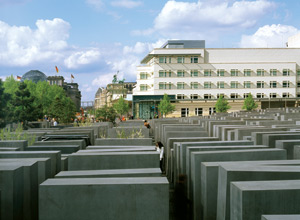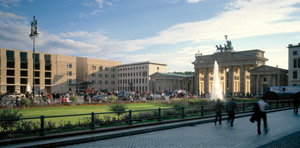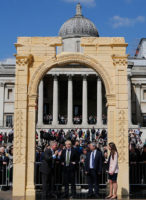All those bollards and barriers are described as necessary for security. But in fact they’re dealing with only a single threat: car bombs. There are, obviously, other kinds of terrorism: biological; electronic (in which the enemy disables computer systems and records); or even, in the worst case, nuclear. When you lock the door against one kind of terrorism, another one may open. I’m not an expert in security, but I’d guess that the most useful antiterrorist weapons don’t require the defacing of architecture. These are, surely, intelligence, surveillance, and redundancy.


Security did other damage. By shrinking the building back from the streets to create the no-man’s-land, the government, of course, reduced the size of the floor plate.
It thus casually destroyed the best single idea the architects originally had. This was their brave decision to build one wing directly along the east property line, sharing a party wall with what later became the wonderful DZ Bank building by Frank Gehry. None of the other competitors had the nerve to do this, although it turned out that the State Department had no objection. By this simple move, MRY achieved an infinitely superior plan, a squared-off figure 8 in which the cross bar was a social center — the “lodge” — that pulled the whole design together. Now MRY’s building, too, has been squeezed like all the others into a C-shape plan with dead-end corridors, and with the DZ now exposed as a huge windowless blank wall along the courtyard. Security also required that windows be no larger than 30 percent of floor area, thus mandating a facade that is peppered with repetitious identical windows that remind you of a prison.
Finally comes the question of meaning. Any building, of course, must possess two basic qualities: It must function for its users, and it must express some meaning to the world outside. “It’s an office function, not a museum,” we were told by the American ambassador, William Timkin. But a building cannot help being a bearer of messages. And if it there were no desire to broadcast a message, why would we build the embassy in such an internationally prominent location? At Berlin, alas, the message is clear: We hate and fear the world around us, so we’ve retired behind a moat of defendable space.
I realize, of course, that an embassy is a special case. After the bombings of American embassies in Tanzania and Kenya in 1998, and the tragedy of 9/11, it’s clearly necessary to protect users from car-bombers if we wish to build an emblematic national embassy like this one. But that merely raises the whole question of the emblematic embassy.
If a building is placed on a prominent site as an emblem of the presence and prestige of the U.S.A. — a site like the Pariser Platz — then it is advertising itself as a target.
One obvious alternative is to forget about being a nationalist emblem and build, instead, a fortified embassy somewhere on the urban fringe, where it can be safe. The U.S. government has, in fact, built dozens of such embassies in recent years, seldom with the help of a distinguished architect. Here, though, the message is once again clear: We’re running away and hiding; we do not wish to socialize with the locals; and we care nothing for sustainability.
I would speculate that it is just possible that the safer you try to make an embassy, the more dangerous it will be. I’m reminded of that paradox as it was defined by architectural sociologists in the case of elementary schools back in the 1970s. Kids were vandalizing schools, so administrators responded, for a time, by erecting nearly windowless buildings that looked like forts. Studies showed that vandalism went up, not down. The visibly fortified school was especially appealing as a challenge to the vandal. The visibly fortified embassy is, maybe, a similar target to the terrorist.
So what’s the answer? One possibility is to abandon the emblematic embassy. Embassy functions could be dissociated and scattered here and there more or less invisibly through a city, connected by information technology. So far as I could find out at our Berlin conference, there is no research to prove that workers are safer in a defended emblematic embassy than they would be in such a dispersed world. And the concept of the emblematic American embassy, after all, is less than a century old. It arose in the wake of nationalism in the early 20th century. Before that, diplomatic functions were centered in the ambassador’s residence, with no showy billboard presence of an embassy building.
It’s just a thought. But it does seem better than offering to the world, in a major public setting, a message of fear and loathing.
All that said, I still like much about the Berlin embassy. It will certainly improve as landscape plantings by Laurie Olin begin to fill in the no-man’s-land. I have quarrels with some changes the architects made on their own, mostly because they came to believe their marvelous original design was too “genteel” to hold its own in the presence of Gehry’s bold DZ Bank or Foster’s nearby Reichstag. I don’t agree, but that’s a minor matter of taste.
Security guys aren’t the only villains. There were the usual excitable cost-cutters, too. You can’t create a worthy emblem of America with a tightwad’s purse, and in 2002 our government cut an astonishing 40 percent from the embassy’s budget. I’m reminded of the Senate committee that once censured architect Henry Cobb’s federal courthouse in Boston because it committed the sin of having “above-standard light fixtures.”
But the major villain here is the security expert who is, apparently, accountable to no one. Security is important, but let’s keep it in balance with other values. Including good architecture.



Post a comment to this article
Report Abusive Comment